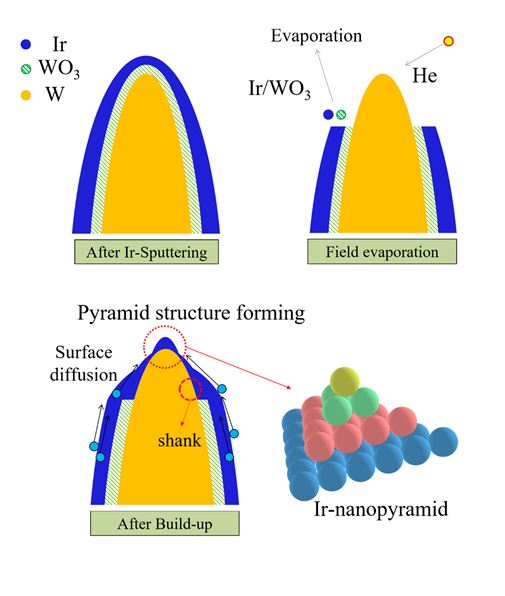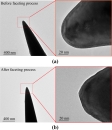Ion Beam Generating Technique to Boost Development of Domestic Ion Microscopes
- Writerkrissadmin
- Date2021-08-26 00:00
- Hits850
Ion Beam Generating Technique to Boost Development of Domestic Ion Microscopes
- Novel Tip Fabrication Technique Produces Ion Beams With High Angular Current Density -
The KRISS research team led by In-yong Park, principal research scientist of the Advanced Instrumentation Institute, and Ji-hwan Kwon, senior research scientist of the Interdisciplinary Materials Measurement Institute, developed an ion beam generating technique that enhances the performance of ion microscopes. This technique, one of the most advanced among ion beam generating methods, is expected to boost the development of high-performance ion microscopes in Korea.
![그림입니다. 원본 그림의 이름: [첨부5] KRISS 연구진 [이하림 POST-DOC(좌), 김광일 UST연구학생(중), 박인용 책임연구원(우)].jpg 원본 그림의 크기: 가로 700pixel, 세로 466pixel 사진 찍은 날짜: 2021년 08월 17일 오후 11:48 카메라 제조 업체 : NIKON CORPORATION 카메라 모델 : NIKON D850 프로그램 이름 : Adobe Photoshop CS6 (Windows) F-스톱 :](https://www.kriss.re.kr/ease_src/crosseditor/binary/images/000005/20211027103958462_Y4JREG3I.jpg)
▲ KRISS researchers
[Ha-rim Lee (post-doc, left), Kwang-il Kim (UST student researcher, middle), In-yong Park (principal research scientist, right)]
Advanced microscopes with nanoscale resolution, including ion microscopes, are essential for the development of various materials, parts, and biotechnology. Korea’s microscope industry is highly dependent on imports, and more efforts are needed to develop domestic microscopes.
Ion beam generating technology is what drives ion microscopes and other equipment that use charged particle beams for imaging and analysis. As such, it is important to produce high-quality ion beams for use in such equipment.
Tungsten, which is typically used to create ion beam generating tips*, corrodes in an oxygen environment. Past studies have employed complex chemical treatments and heating processes to leave only non-corrosive iridium atoms, but the number of regenerations was highly limited.
*Tip: A pointed, needle-like end used to create electron beams and ion beams
The team used Ir at the probe end to fabricate a sharp tip comprising no more than three atoms, and succeeded in producing ion beams with high angular current density. Compared to existing methods, the proposed technique has a higher fabrication success rate, and allows more regenerations*, which determines the tip use period.
*Regeneration: Resharpening the tip to within three atoms when the tip becomes blunt from field-evaporation of atoms during beam generation

▲ [Fig. 1] Schematic diagram of formation of nanopyramid structure of tungsten-based Ir probe
? A tip with a curvature radius of 20 nm was created electrochemically. After depositing Ir on the tip and heating under vacuum conditions, an Ir tip was obtained. When the tip became blunt, it was heated again to a temperature of 1000 K. The number of generations was verified as more than 30.

▲ [Fig. 3] Comparison of TEM images before and after faceting
Ion beam processors created using the proposed technique will be capable of high-resolution patterning* and deposition*, and contribute to the development of advanced devices and semiconductor processes. Moreover, the technique can be applied to the production of domestic ion microscopes, enhancing Korea’s global competitiveness in high-performance ion microscopy.
*Patterning: Creating desired patterns on the surface of a specimen through collision with ion beams; Use of ion beams allows maskless patterning
*Deposition: Applying a thin coating, such as metal, onto a specimen
In-yong Park, principal research scientist of the Advanced Instrumentation Institute, said, “With our novel Ir tip fabrication technique, we can produce stable ion beams that do not corrode upon exposure to gas and have high angular current density. It can be applied to the development of domestic research equipment, including ion sources of ion microscopes, and probes used in oxygen environments.”
Based on these achievements, the team plans to further stabilize beams, and conduct follow-up research on beam characteristic analysis.
![그림입니다. 원본 그림의 이름: [첨부6] KRISS 연구진이 진공환경에서 이온빔 생성용 팁제작 실험을 하고 있다.jpg 원본 그림의 크기: 가로 700pixel, 세로 466pixel 사진 찍은 날짜: 2021년 08월 17일 오후 11:18 카메라 제조 업체 : NIKON CORPORATION 카메라 모델 : NIKON D850 프로그램 이름 : Adobe Photoshop CS6 (Windows) F-스톱 : 11.0 노출 시간 : 10/3](https://www.kriss.re.kr/ease_src/crosseditor/binary/images/000005/20211027103958468_S4W51MVI.jpg)
▲ KRISS researchers are conducting a tip fabrication experiment for ion beam generation under vacuum conditions.
The results of the study, funded by KRISS, were published in the online version of Microscopy and Microanalysis in July.

